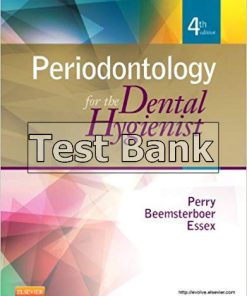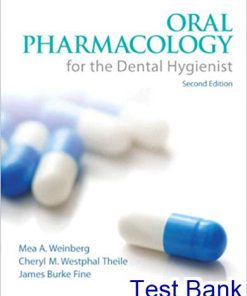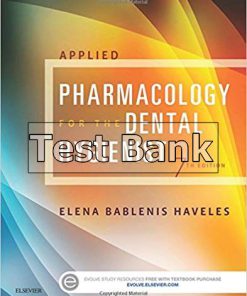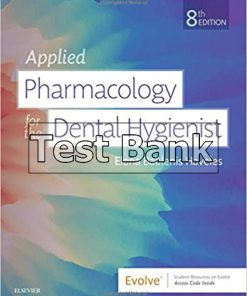Oral Pathology for the Dental Hygienist 6th Edition Ibsen Test Bank
$50.00 Original price was: $50.00.$26.50Current price is: $26.50.
Oral Pathology for the Dental Hygienist 6th Edition Ibsen Test Bank.
This is completed downloadable of Oral Pathology for the Dental Hygienist 6th Edition Ibsen Test Bank
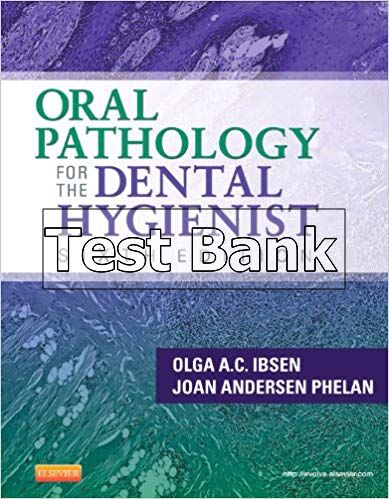
Product Details:
- ISBN-10 : 1455703702
- ISBN-13 : 978-1455703708
- Author: Olga A. C. Ibsen RDH MS (Author), Joan Andersen Phelan DDS (Author)
Oral Pathology for the Dental Hygienist is your source for the most trusted content in oral pathology. With more than 50 years of combined real-world experience, Olga Ibsen and Joan Phelan have created a text that offers the ideal combination of clinical photographs, radiographs and discussion to help you identify, understand, evaluate, and document the appearance of normal and disease states. This user-friendly, atlas-style text features the learning tools and updated content you need to prepare for success on your exams and throughout your professional career.
Table of Content:
- Chapter 1 Introduction to Preliminary Diagnosis of Oral Lesions
- Objectives
- Vocabulary
- Clinical Appearance of Soft Tissue Lesions
- Soft Tissue Consistency
- Color of Lesion
- Size of Lesion
- FIGURE 1-1 Lobulated torus palatinus.
- FIGURE 1-2 Fibroma with a pedunculated base. Arrow points to the stemlike base.
- FIGURE 1-3 Fibroma with a sessile base.
- FIGURE 1-4 A ruler measuring centimeters is used to measure all specimens submitted for microscopic examination.
- Surface Texture
- Radiographic Terms Used to Describe Lesions in Bone
- FIGURE 1-5 A, Probe measuring the diameter of a fibroma with a sessile base. B, Gutta-percha point used to explore a radiographic defect. C, Periodontal probe placed before a radiograph.
- FIGURE 1-6 Squamous cell carcinoma involving the alveolar bone and hard palate showing diffuse borders.
- FIGURE 1-7 Odontogenic keratocyst (arrow), illustrating a multilocular lesion.
- FIGURE 1-8 Prominent pulp chambers, horns, and canals in mandibular molars.
- FIGURE 1-9 A, Stage I periapical cemento-osseous dysplasia (cementoma). B, Stage II periapical cemento-osseous dysplasia (cementoma).
- FIGURE 1-10 Amalgam restorations on the occlusal surfaces of the maxillary and mandibular molars.
- FIGURE 1-11 Resorption of the roots on maxillary anteriors as a result of rapid orthodontic movement.
- FIGURE 1-12 Traumatic bone cyst (arrows) around the roots.
- FIGURE 1-13 Radicular cyst (arrow) at the apex of the maxillary lateral incisor, illustrating a unilocular lesion.
- FIGURE 1-14 Well-circumscribed median palatal cyst (arrow).
- The Diagnostic Process
- Making A Diagnosis
- Clinical Diagnosis
- FIGURE 1-15 Fordyce granules.
- FIGURE 1-16 Lobulated torus palatinus.
- FIGURE 1-17 Arrows point to mandibular tori.
- FIGURE 1-18 Melanin pigmentation.
- FIGURE 1-19 Arrows point to the retrocuspid papillae on the gingival margin of the lingual aspect of the mandibular cuspids.
- FIGURE 1-20 Fissured tongue.
- FIGURE 1-21 Median rhomboid glossitis (top arrow) and geographic tongue (bottom arrows).
- FIGURE 1-22 Geographic tongue. Arrows point to areas of depapillation.
- Radiographic Diagnosis
- FIGURE 1-23 A, White hairy tongue. B, White hairy tongue showing a circumvallate papilla (arrow). C, Black hairy tongue.
- FIGURE 1-24 Arrow points to an amalgam tattoo at the apical area of the patient’s maxillary right central incisor. This patient had a root canal procedure on a deciduous tooth. No other amalgam restoration is in the area; therefore it was helpful to know the patient’s past dental history to confirm this diagnosis.
- FIGURE 1-25 A, Periapical pathosis (PAP); a radiolucency is seen at the apex of the mandibular second premolar (arrow). B, In another patient a fistula is seen on the maxillary lateral incisor. A fistula is usually an indication of PAP. When a fistula is observed clinically, a radiograph is necessary for diagnostic and treatment purposes.
- FIGURE 1-26 Arrow points to the area of internal resorption on the maxillary first molar.
- FIGURE 1-27 Arrow points to external resorption on a mandibular central incisor.
- FIGURE 1-28 Arrows point to heavy interproximal calculus.
- FIGURE 1-29 A, Dental caries. The reader should observe the interproximal radiolucencies. Clinical examination is necessary to confirm the involvement of some of the areas. B, Periapical radiograph showing a subtle carious area on the distal aspect of the mandibular second premolar. C, The patient in (B) was seen a year later. During the scaling procedure a defect on the distal aspect of the mandibular second premolar was detected. This vertical bitewing radiograph was taken. The reader should note the definite radiolucent, carious area on the distal aspect of the mandibular second premolar. This example emphasizes the need for careful clinical and radiographic evaluation.
- FIGURE 1-30 Arrow points to compound odontoma.
- FIGURE 1-31 A, Compound odontoma rather easily diagnosed from the radiograph alone. B, Complex odontoma (arrow) not diagnosed from the radiograph alone.
- FIGURE 1-32 A, Mesiodens (arrow). A supernumerary tooth is located between the maxillary central incisors. B, A radiograph showing a supernumerary mandibular premolar (arrow) surrounded by a radiolucent area diagnosed as a dentigerous cyst. Clinically this area was thought to be a mandibular torus (until the radiograph was taken).
- FIGURE 1-33 A, Impacted mandibular cuspid. B, Impacted maxillary cuspid.
- FIGURE 1-34 Calcified pulp in the mandibular first molar.
- Historical Diagnosis
- FIGURE 1-35 A, Nutrient canals in the anterior maxillary arch. B, Nutrient canals in the mandibular anterior area. C, The mixed dentition of a 5-year-old child is observed in this radiograph.
- FIGURE 1-36 A, Arrow points to a 7-carat cubic zirconia (a round stone) that was glued to this patient’s maxillary left central incisor. B, The radiopaque area on the distal aspect of the mandibular second premolar (arrow) is an amalgam fragment. There was a subtle clinical amalgam tattoo in the interproximal papilla that was not detected or charted on initial examination, which included a full-mouth series of radiographs and incomplete scaling. When the radiographs were viewed after the patient was dismissed, the radiopaque area was thought to be the tip of a broken instrument. Further evaluation of the instruments used at that appointment ruled out the possibility of a broken instrument. When the patient returned for an additional appointment 2 weeks later, another radiograph, using the same long cone and precision Rinn instruments, was taken of the area. The radiopaque fragment remained in the exact same place. Clinically, a very close look at the interproximal papilla in the area then revealed a subtle bluish-black area. The dentist surgically slit the papilla on the buccal aspect and revealed the amalgam particle. C, This patient wore wide-framed eyeglasses during the radiographic procedure. The arrow points to a U-shaped radiopacity from the eyeglass frame. D, This radiograph reveals an obvious radiopaque overhang from the amalgam restoration on the distal aspect of the mandibular first molar. E, Instruments from a root canal procedure were broken in these two maxillary lateral incisors (arrows). F, The broken tip of a curet (arrow) is observed as a radiopaque area on the distal aspect of the maxillary first premolar. G, Arrow points to a retained deciduous tooth with an amalgam restoration. H, Arrow points to a radiopaque area that identifies a retained shotgun pellet on the distal aspect of the mandibular third molar. I, Arrow points to a radiopaque circular area that is a nose ring. J, Periapical radiograph showing a radiopaque area at the apex of the mesial root of the mandibular second molar. This object was a retained piece of shrapnel. K, Panoramic radiograph of the same patient showing the same object (arrow). This radiograph gives a more accurate view of the location of the object. It was found to be in the soft tissue in the area and not within bone.
- FIGURE 1-37 A, One of the clinical appearances of amelogenesis imperfecta. B, The radiographic aspect of amelogenesis imperfecta.
- FIGURE 1-38 A, Clinical appearance of dentinogenesis imperfecta. B, Radiographic appearance of dentinogenesis imperfecta.
- Laboratory Diagnosis
- FIGURE 1-39 A, Oral ulcers on the soft palate associated with ulcerative colitis. B, Gingival enlargement seen in a patient taking nifedipine, a calcium channel blocker. C and D, Urticaria. D, Same patient as in C 8 hours later.
- FIGURE 1-40 Skin grafts performed to enhance the mandibular ridge in (A) a white patient and (B) a black patient. Without the patients’ past medical and dental histories, it would be difficult to diagnose this anomaly of melanosis accurately.
- FIGURE 1-41 Radiographic appearance of Paget disease, showing the traditional irregular radiopacities (“cotton-wool effect”) in bone characteristic of this disease.
- Microscopic Diagnosis
- FIGURE 1-42 A, A white lesion is seen on the anterior floor and ventral surface of the tongue. B, Microscopic examination of the white lesion showed a thickened keratin layer, called hyperkeratosis, and some atypical changes in the basal layer of the epithelium (mild epithelial dysplasia). C, Erythroplakia (arrow) in this case diagnosed microscopically as squamous cell carcinoma.
- Surgical Diagnosis
- Therapeutic Diagnosis
- Differential Diagnosis
- FIGURE 1-43 Traumatic bone cyst.
- FIGURE 1-44 Arrow points to a static (Stafne) bone cyst.
- FIGURE 1-45 Angular cheilitis.
- FIGURE 1-46 A, Necrotizing ulcerative gingivitis (NUG). B, Another example of NUG. The clinician should note the gingival contours and punched-out, blunted papillae.
- Box 1-1 Case Study
- FIGURE 1-47 Arrow points to a pyogenic granuloma between the patient’s right maxillary central and lateral incisors.
- Variants of Normal
- Fordyce Granules
- FIGURE 1-48 Fordyce granules on the buccal mucosa.
- FIGURE 1-49 A, Radiopaque appearance of torus palatinus (arrows). B, Clinical appearance of torus palatinus.
- Torus Palatinus
- Mandibular Tori
- Melanin Pigmentation
- FIGURE 1-50 A, Clinical appearance of lobulated mandibular tori. B, Radiopaque appearance of mandibular tori in same patient.
- FIGURE 1-51 Melanin pigmentation of the mandibular gingiva.
- Retrocuspid Papilla
- Lingual Varicosities
- Linea Alba
- FIGURE 1-52 Lingual varices.
- FIGURE 1-53 Arrow points to linea alba on the buccal mucosa.
- FIGURE 1-54 Leukoedema of the buccal mucosa, showing an opalescent, velvety texture.
- Leukoedema
- Benign Conditions of Unknown Cause
- Lingual Thyroid Nodule
- Median Rhomboid Glossitis
- Geographic Tongue
- FIGURE 1-55 Median rhomboid glossitis.
- FIGURE 1-56 A, Geographic tongue. B, Ectopic geographic tongue observed in the mandibular anterior mucosa.
- Fissured Tongue
- Hairy Tongue
- FIGURE 1-57 Fissured tongue and attrition.
- FIGURE 1-58 White hairy tongue.
- FIGURE 1-59 Black hairy tongue.
- Selected References
- Books
- Journal Articles
- Review Questions media
- CHAPTER 1 SynopsisView PDFmedia
- Pageburst Integrated Resource
- Activities
- Chapter 2 Inflammation and Repair
- Objectives
- Vocabulary
- Injury
- Innate Defenses
- Inflammation
- Microscopic Events of Inflammation and Clinical Signs
- TABLE 2-1 Local and Systemic Clinical Signs of Inflammation and Associated Microscopic Events
- Box 2-1 Inflammatory Response: Sequence of Events
- FIGURE 2-1 Microscopic events during inflammation.
- FIGURE 2-2 Microscopic view of a blood vessel showing margination and pavementing of neutrophils (N) at the periphery of a small blood vessel during inflammation.
- FIGURE 2-3 Swelling caused by increased local edema associated with a dental infection. The patient was hospitalized for treatment of the swelling.
- FIGURE 2-4 Fistulas formed from periapical abscesses. A, A fistula formed from an abscess associated with a mandibular first molar. B, The opening of a fistulous tract from a mandibular incisor is noted on the skin of the chin. C, A periapical radiolucency at the area of abscess causing the fistula to the skin in (B).
- FIGURE 2-5 An intraoral abscess has been incised, and a drain (arrow) placed to allow the escape of purulent exudate from the tissue.
- FIGURE 2-6 Phagocytosis of a foreign substance (bacterium) by a white blood cell. The foreign substance will later be destroyed by digestion within the cell by lysosomal enzymes that are contained within lysosomes.
- White Blood Cells in the Inflammatory Response
- Neutrophils
- FIGURE 2-7 Changes in the white blood cell population of injured tissue over time, starting with acute inflammation, continuing to chronic inflammation, and extending to the beginning of the immune response.
- FIGURE 2-8 Microscopic view of acute inflammation, showing an increase in the number of neutrophils. Macrophages are also present (medium magnification).
- FIGURE 2-9 Microscopic view of chronic inflammation and the beginning of the immune response, mainly showing macrophages, lymphocytes, and plasma cells (medium magnification).
- FIGURE 2-10 A neutrophil has a multilobed nucleus and granular cytoplasm.
- Macrophages
- FIGURE 2-11 Derivation of white blood cells from a stem cell in the bone marrow.
- FIGURE 2-12 A macrophage. This cell was a monocyte when circulating in the blood.
- Biochemical Mediators of Inflammation
- Kinin System
- Clotting Mechanism
- Complement System
- Other Biochemical Mediators of Inflammation
- Systemic Manifestations of Inflammation
- Fever
- Leukocytosis
- Lymphadenopathy
- FIGURE 2-13 Enlarged cervical lymph node.
- FIGURE 2-14 Location of lymph nodes in the neck.
- Elevated C-Reactive Protein
- Chronic Inflammation
- Antiinflammatory Drugs
- Reactive Tissue Responses
- FIGURE 2-15 Microscopic appearance of epithelial hyperplasia (low magnification). The epithelium (E) is thickened because of an increase in the number of cells in the spinous layer. CT, underlying connective tissue.
- Regeneration and Repair
- Microscopic Events during Repair
- Day of Injury
- FIGURE 2-16 Underlying microscopic events of the repair process from the day of injury to 2 weeks later.
- Day after Injury
- Two Days after Injury
- Seven Days after Injury
- FIGURE 2-17 Use of sutures to encourage healing by primary intention.
- Two Weeks after Injury
- Types of Repair
- Healing by Primary Intention
- Healing by Secondary Intention
- FIGURE 2-18 Healing by secondary intention (without the use of sutures) in a large injury.
- FIGURE 2-19 Example of keloid formation (excessive scar tissue formation) after an injury.
- Healing by Tertiary Intention
- Factors That Impair Healing
- Bone Tissue Repair
- Traumatic Injuries to Teeth
- Attrition
- FIGURE 2-20 A, Attrition of adult dentition. B, Attrition of adult dentition (incisal view).
- FIGURE 2-21 Attrition has caused the flattening of the cusps (wear facets) of both the maxillary and mandibular cuspid teeth.
- FIGURE 2-22 Attrition of the mandibular anterior teeth resulting from bruxism.
- Abrasion
- FIGURE 2-23 Abrasion at the cervical area of mandibular bicuspids caused by toothbrushing.
- Abfraction
- Erosion
- FIGURE 2-24 Abfraction.
- FIGURE 2-25 A, Erosion of buccal and labial surfaces of teeth that occurred as a result of accidental exposure to sulfuric acid. Erosion caused by bulimia: B, Decreased tooth size. C, Erosion of maxillary lingual surfaces.
- FIGURE 2-26 Extensive dental destruction related to methamphetamine abuse.
- Injuries to Oral Soft Tissues
- Oral Mucosal Burns
- Aspirin Burn
- Phenol and Other Chemical Burns
- FIGURE 2-27 A and B, Aspirin burns.
- Electric Burn
- Thermal Burns
- Lesions Associated with Cocaine Use
- FIGURE 2-28 Mucosal burns. A, Chemical burn caused by contact with caustic material during endodontic treatment. B, Thermal burn of palate caused by contact with hot soup. C, Ulcer of midline of palate caused by heat generated during the use of crack cocaine.
- Lesions From Self-Induced Injuries
- Hematoma
- Traumatic Ulcer
- FIGURE 2-29 Hematoma on the buccal mucosa.
- FIGURE 2-30 A, Traumatic ulceration caused by irritation of gingiva by fingernails. B, Traumatic ulcer caused by denture. C, Traumatic ulcer on lateral tongue caused by chronic trauma to tongue by teeth. D, Traumatic ulcer (traumatic granuloma) of buccal mucosa.
- FIGURE 2-31 Frictional keratosis (indicated by arrow) caused by an opposing third molar (A), and chronic tongue chewing (B). C, Microscopic appearance of hyperkeratosis (low magnification) showing an increase in surface keratin (K).
- Frictional Keratosis
- FIGURE 2-32 Linea alba.
- Linea Alba
- Nicotine Stomatitis
- FIGURE 2-33 Nicotine stomatitis.
- Smokeless Tobacco–associated Keratosis
- Traumatic Neuroma
- FIGURE 2-34 Smokeless tobacco–associated keratosis. Note the rough texture of the surface. A, Labial mucosa. B, Anterior buccal mucosa.
- Amalgam Tattoo
- FIGURE 2-35 A, This bluish-gray pigmentation of the gingiva is an amalgam tattoo. B, Periapical radiograph showing amalgam particles in the gingival tissue.
- Melanosis
- FIGURE 2-36 A, Posttraumatic melanin pigmentation: area of melanin pigmentation on the gingiva after healing of a traumatic injury. B, Oral melanotic macules on the buccal mucosa.
- Solar Cheilitis
- FIGURE 2-37 Solar cheilitis. The color of the vermilion appears mottled and the interface between the vermilion and skin is indistinct.
- Mucous Retention Lesions
- FIGURE 2-38 Mucocele of the lower lip. A, Fluid-filled lesion is seen on the lower lip. B, Microscopic appearance of a mucocele, showing a cystlike space lined by granulation tissue (low magnification).
- FIGURE 2-39 Ranula.
- FIGURE 2-40 Sialoliths.A, Sialolith (arrow) in a minor salivary gland on the floor of the mouth. B, Microscopic appearance of a sialolith, showing concentric rings.
- Sialolith
- FIGURE 2-41 A, Occlusal radiograph showing a sialolith (arrow) in Wharton’s duct. B, A panoramic radiograph showing a sialolith (arrow).
- FIGURE 2-42 Necrotizing sialometaplasia.
- Necrotizing Sialometaplasia
- Sialadenitis
- Reactive Connective Tissue Hyperplasia
- Pyogenic Granuloma
- FIGURE 2-43 Pyogenic granuloma.
- FIGURE 2-44 Pyogenic granuloma of pregnancy (pregnancy tumor).
- Peripheral Giant Cell Granuloma
- Irritation Fibroma, Focal Fibrous Hyperplasia
- FIGURE 2-45 A, Peripheral giant cell granuloma. B and C, Microscopic appearance of a peripheral giant cell granuloma. Low magnification (A) shows the surface epithelium. Higher magnification (C) shows multinucleated giant cells (M), capillaries, and fibroblasts.
- FIGURE 2-46 Irritation fibroma. A, Development of fibroma followed by the healing of a periodontal abscess. B, Irritation fibroma of the buccal mucosa. C, Microscopic appearance of a fibroma.
- FIGURE 2-47 Denture-induced fibrous hyperplasia (epulis fissuratum; arrows). A, With denture; B, without denture.
- Denture-Induced Fibrous Hyperplasia
- Inflammatory Papillary Hyperplasia of the Palate
- FIGURE 2-48 Papillary hyperplasia of the palate. A, Full denture. B, Partial denture.
- Gingival Enlargement
- FIGURE 2-49 Gingival enlargement. A, Fibrous. B, Inflamed.
- Chronic Hyperplastic Pulpitis
- FIGURE 2-50 Chronic hyperplastic pulpitis (pulp polyp) (arrow).
- Inflammatory Periapical Lesions
- Periapical Abscess
- Periapical Granuloma
- FIGURE 2-51 A, Radiograph of a periapical granuloma. B, Microscopic appearance of a periapical granuloma, showing a collection of inflammatory cells at the apex of a tooth (low magnification).
- Radicular Cyst (Periapical Cyst)
- Tooth Resorption
- FIGURE 2-52 Radicular cyst. A, Diagram of a radicular cyst located around the root of an erupted tooth. B, Radiograph showing a well-circumscribed radiolucency (arrow) around the root of a tooth. C, Microscopic features of a radicular cyst.
- Focal Sclerosing Osteomyelitis
- FIGURE 2-53 A, Diagram of a residual cyst. B, Radiograph of a residual cyst, showing radiolucency at the site of a previously extracted tooth.
- FIGURE 2-54 Tooth resorption. A, Root resorption of a mandibular anterior tooth associated with chronic inflammation. B, Resorption of tooth structure and bone because of chronic inflammation. C, Idiopathic resorption of an impacted tooth. D, Generalized root resorption associated with orthodontic tooth movement.
- Alveolar Osteitis
- FIGURE 2-55 Focal sclerosing osteomyelitis (condensing osteitis).
- Selected References
- Books
- Journal Articles
- Lesions from Physical and Chemical Injuries to the Oral Tissues
- Reactive Connective Tissue Hyperplasia
- Inflammatory Periapical Lesions
- Websites
- Review Questions media
- CHAPTER 2 SynopsisView PDFmedia
- Pageburst Integrated Resource
- Activities
- Chapter 3 Immunity and Immunologic Oral Lesions
- Objectives
- Vocabulary
- Acquired Immune Response
- Antigens
- Cellular Involvement in the Immune Response
- B-Cell Lymphocyte
- FIGURE 3-1 Primary cells of the immune response include the lymphocytes, both B-cell lymphocytes and T-cell lymphocytes. Lymphocytes, polymorphonuclear neutrophils (PMN) and, macrophages are derived from stem cells in the bone marrow.
- FIGURE 3-2 Antibody or immunoglobulin (Ig) basic structure, with four protein chains with two identical heavy polypeptide chains and two identical light chains, forming a Y-shape. The tips of the arms are called the variable region because they vary greatly, creating a pocket uniquely shaped to enfold or “bind” a specific antigen (Fab). The stem or base, called the constant region, is identical in all antibodies of the same class and serves to link the antibody to other cells and products in the immune response (Fc).
- TABLE 3-1 Immunoglobulins (Antibodies)
- FIGURE 3-3 Five general types of antibodies or immunoglobulins in serum include the same basic structure arranged differently. This variation in structure allows them to function differently.
- FIGURE 3-4 Various types of T-cell lymphocytes and their involvement in the immune response.
- T-Cell Lymphocyte
- Natural Killer Cell
- Macrophage
- Dendritic Cell
- TABLE 3-2 Cytokines
- Cytokines
- Major Divisions of the Immune Response
- Memory and Immunity
- Types of Immunity
- FIGURE 3-5 The two major divisions of the immune response: humoral immunity and cell-mediated immunity.
- Immunopathology
- Hypersensitivity
- Type I Hypersensitivity
- TABLE 3-3 Hypersensitivity Reactions
- Type II Hypersensitivity
- Type III Hypersensitivity
- Type IV Hypersensitivity
- Hypersensitivity to Drugs
- Autoimmune Diseases
- Immunodeficiency
- Oral Immunologic Lesions and Diseases
- Aphthous Ulcers, Recurrent Aphthous Ulcers
- Types of Aphthous Ulcers
- FIGURE 3-6 Minor aphthous ulcers. A, On the floor of the mouth. B, On the buccal mucosa, on the papilla of the Stenson duct.
- Diagnosis
- FIGURE 3-7 Major aphthous ulcers. A, On the labial mucosa. B, On the soft palate. C, On the buccal mucosa.
- FIGURE 3-8 Herpetiform aphthous ulcers on the palate. These are the smallest of the aphthous ulcers.
- Treatment and Prognosis
- FIGURE 3-9 A and B, Two examples of urticaria (hives).
- TABLE 3-4 Clinical Features of the Three Types of Recurrent Aphthous Ulcers
- Urticaria and Angioedema
- FIGURE 3-10 Angioedema.
- Diagnosis
- Treatment and Prognosis
- Contact Mucositis and Dermatitis
- Diagnosis
- Treatment and Prognosis
- Fixed Drug Eruptions
- FIGURE 3-11 A, Contact mucositis on the labial mucosa, from acrylic. B, Contact dermatitis on the skin between the thumb and index finger, from latex gloves.
- Erythema Multiforme
- FIGURE 3-12 Skin lesions of erythema multiforme. A, Target lesion (arrow). B, Bullae.
- Diagnosis
- Treatment and Prognosis
- Lichen Planus
- FIGURE 3-13 Oral lesions of erythema multiforme. A, Crusted lip lesions with edema, ulceration, and erythema. B, Erythematous and ulcerated lesions of the lips and buccal mucosa. C, Stevens-Johnson syndrome.
- FIGURE 3-14 A and B, Two examples of the oral lesions of lichen planus. C, The plaquelike lesions on the tongue of a patient with lichen planus.
- Types of Lichen Planus
- FIGURE 3-15 Erosive lichen planus on the buccal mucosa.
- Diagnosis
- FIGURE 3-16 Desquamative gingivitis seen in lichen planus.
- FIGURE 3-17 Skin lesions of lichen planus presenting as scaly purplish lesions.
- FIGURE 3-18 Microscopic appearance of lichen planus. Degeneration of the basal cell layer of the epithelium (B) and the bandlike infiltrate of lymphocytes (L).
- Treatment and Prognosis
- Reactive Arthritis (Reiter Syndrome)
- Diagnosis
- Treatment and Prognosis
- Langerhans Cell Histiocytosis (Langerhans Cell Disease)
- FIGURE 3-19 Reactive arthritis. A, Ulcerative lesions on the palate. B, Lesion on the tongue.
- FIGURE 3-20 Langerhans cell histiocytosis (Langerhans cell disease) microscopic appearance (high magnification) with a combination of Langerhans cells and eosinophils.
- FIGURE 3-21 Langerhans cell histiocytosis (Langerhans cell disease): chronic disseminated form also known as Hand-Schüller-Christian disease. A, Skull radiograph. B, Ulcerated lesion of the mandible.
- FIGURE 3-22 Langerhans cell histiocytosis (Langerhans cell disease) in the solitary or chronic localized form of an eosinophilic granuloma, showing a well-circumscribed radiolucency.
- Treatment and Prognosis
- Autoimmune Diseases with Oral Manifestations
- Sjögren Syndrome
- TABLE 3-5 Autoimmune Diseases with Oral Manifestations
- FIGURE 3-23 Sjögren syndrome with severe xerostomia and a lack of papillae on the dorsal tongue.
- FIGURE 3-24 Bilateral parotid gland enlargement seen in Sjögren syndrome.
- FIGURE 3-25 Microscopic appearance (high magnification) of a minor salivary gland in Sjögren syndrome, showing aggregates of lymphocytes surrounding the salivary gland ducts.
- Diagnosis
- Treatment and Prognosis
- FIGURE 3-26 Sialogram of the parotid gland in Sjögren syndrome.
- Systemic Lupus Erythematosus
- FIGURE 3-27 A and B, Skin lesions of lupus erythematosus.
- Diagnosis
- Treatment and Prognosis
- Pemphigus Vulgaris
- FIGURE 3-28 A and B, Oral lesions of lupus erythematosus.
- Diagnosis
- Treatment and Prognosis
- FIGURE 3-29 A-C, Oral lesions in pemphigus vulgaris.
- FIGURE 3-30 Microscopic appearance of pemphigus vulgaris (low magnification), showing acantholysis of the epithelium and the intact basal layer attached to the connective tissue.
- Mucous Membrane Pemphigoid
- Diagnosis
- FIGURE 3-31 Desquamative gingivitis in mucous membrane pemphigoid.
- Treatment and Prognosis
- Bullous Pemphigoid
- FIGURE 3-32 Microscopic appearance of mucous membrane pemphigoid (low magnification), showing a separation of the epithelium from the connective tissue at the basement membrane area.
- Diagnosis
- Treatment and Prognosis
- Behçet Syndrome
- FIGURE 3-33 Aphthous-like ulcer on the tongue in Behçet syndrome.
- Diagnosis
- Treatment and Prognosis
- Selected References
- Books
- Journal Articles
- Immunologic Oral Lesions
- Websites
- Review Questions media
- CHAPTER 3 SynopsisView PDFmedia
- Pageburst Integrated Resource
- Activities
- Chapter 4 Infectious Diseases
- Objectives
- Vocabulary
- Bacterial Infections
- Impetigo
- Tonsillitis and Pharyngitis
- Tuberculosis
- FIGURE 4-1 This ulcer on the tongue tested positive for tuberculosis organisms.
- Diagnosis
- Treatment and Prognosis
- Actinomycosis
- FIGURE 4-2 Actinomycosis. The skin lesion is over the mandible, and the incision and drainage site is seen below the lesion. “Sulfur granules” were noted in the exudate draining from the site, and the condition was treated with long-term antibiotic therapy.
- TABLE 4-1 Stages of Syphilis
- Syphilis
- Congenital Syphilis
- Diagnosis and Treatment
- FIGURE 4-3 A, Chancre on tongue seen in primary syphilis. B, Chancre on lip.
- Necrotizing Ulcerative Gingivitis
- Pericoronitis
- Diagnosis
- FIGURE 4-4 Necrotizing ulcerative gingivitis.
- FIGURE 4-5 Pericoronitis.
- Treatment and Prognosis
- Acute Osteomyelitis
- Diagnosis
- FIGURE 4-6 A, Low-power microscopy of acute osteomyelitis, showing nonviable bone. Bacterial colonies and inflammatory cells are seen between trabeculae of bone. B, Diffuse, irregular radiographic changes seen in chronic osteomyelitis.
- Treatment and Prognosis
- Chronic Osteomyelitis
- Diagnosis
- Treatment
- Fungal Infections
- Candidiasis
- Types of Oral Candidiasis
- FIGURE 4-7 Pseudomembranous candidiasis.
- FIGURE 4-8 Erythematous candidiasis. A, Recent-onset and erythematous lesions elsewhere in the oral cavity differentiate this from median rhomboid glossitis. B, Response to antifungal treatment confirmed the diagnosis of oral candidiasis in this patient.
- Box 4-1 Conditions Associated with Overgrowth of Candida albicans
- Pseudomembranous Candidiasis
- Erythematous Candidiasis
- FIGURE 4-9 Chronic atrophic candidiasis (denture stomatitis). A, Full denture. B, Partial denture.
- Denture Stomatitis
- Chronic Hyperplastic Candidiasis
- FIGURE 4-10 Chronic hyperplastic candidiasis. The white appearance of the tongue did not wipe off, and it disappeared with antifungal treatment.
- FIGURE 4-11 Angular cheilitis.
- Angular Cheilitis
- FIGURE 4-12 Median rhomboid glossitis.
- Chronic Mucocutaneous Candidiasis
- Median Rhomboid Glossitis (Central Papillary Atrophy)
- Diagnosis and Treatment
- FIGURE 4-13 Photomicrograph of a smear showing epithelial cells and Candida organisms.
- Deep Fungal Infections
- Diagnosis
- FIGURE 4-14 Oral lesions of histoplasmosis in this patient clinically resemble squamous cell carcinoma.
- Treatment
- Mucormycosis
- Viral Infections
- Human Papillomavirus Infection
- FIGURE 4-15 Koilocytes in oral epithelium indicate human papilloma virus infection.
- FIGURE 4-16 A and B, Verruca vulgaris on the tongue of a child with a similar lesion on the thumb.
- Verruca Vulgaris
- FIGURE 4-17 Verruca vulgaris on the lateral aspect of the tongue in an adult.
- FIGURE 4-18 Condyloma acuminatum. The presence of condyloma acuminatum in a child is strongly suggestive of sexual abuse.
- Diagnosis
- Treatment and Prognosis
- Condyloma Acuminatum
- FIGURE 4-19 Multifocal epithelial hyperplasia.
- Multifocal Epithelial Hyperplasia
- Herpes Simplex Infection
- Primary Herpetic Gingivostomatitis
- Recurrent Herpes Simplex Infection
- FIGURE 4-20 A, Primary herpetic gingivostomatitis in a child. B and C, Primary herpetic gingivostomatitis in an adolescent.
- FIGURE 4-21 Herpes labialis. A, Twelve hours after onset. B, Forty-eight hours after onset.
- FIGURE 4-22 A and B, Recurrent intraoral herpes simplex.
- Diagnosis
- FIGURE 4-23 A, Herpetic whitlow in a dental hygienist (initial lesion). B, Recurrent lesion occurred many, many years later.
- TABLE 4-2 Comparison of the Clinical Features of Recurrent Minor Aphthous Ulcers and Recurrent Herpes Ulceration
- Treatment
- FIGURE 4-24 Herpetic eye infection.
- FIGURE 4-25 Cytologic smear preparation showing a virally altered cell (Tzanck cell) resulting from herpes simplex infection.
- Varicella-Zoster Virus
- Chickenpox
- Herpes Zoster
- FIGURE 4-26 Chickenpox. A, Skin lesions. B, Gingival lesion.
- FIGURE 4-27 Herpes zoster. A, Unilateral distribution of vesicles along the distribution of a sensory nerve. B, Many vesicles coalesce to form large lesions.
- FIGURE 4-28 Diagram of the branches of the trigeminal nerve.
- Diagnosis
- Treatment
- Epstein-Barr Virus Infection
- FIGURE 4-29 Herpes zoster. A, Unilateral facial lesions occurring along the distribution of the maxillary branch of the trigeminal nerve. B, Intraoral lesions in the same patient illustrate the unilateral distribution of herpes zoster.
- Infectious Mononucleosis
- FIGURE 4-30 Hairy leukoplakia seen here in an HIV-infected patient is an oral epithelial lesion caused by the Epstein-Barr virus.
- Hairy Leukoplakia
- Coxsackievirus Infections
- Herpangina
- Hand-Foot-and-Mouth Disease
- FIGURE 4-31 Herpangina.
- Diagnosis
- Treatment
- Acute Lymphonodular Pharyngitis
- Other Viral Infections That May Have Oral Manifestations
- Measles
- Mumps
- Human Immunodeficiency Virus and Acquired Immunodeficiency Syndrome
- The Spectrum of Human Immunodeficiency Virus
- Diagnosing AIDS
- Box 4-2 Definition of Acquired Immunodeficiency Syndrome
- With Laboratory Evidence of Human Immunodeficiency Virus Infection
- Human Immunodeficiency Virus Laboratory Tests Not Performed or Results Inconclusive and the Patient Has No Other Cause of Immunodeficiency
- Human Immunodeficiency Virus Testing
- Clinical Manifestations
- FIGURE 4-32 Spectrum of human immunodeficiency virus (HIV) disease. AIDS, acquired immunodeficiency syndrome.
- Medical Management
- Oral Manifestations
- Oral Candidiasis
- Box 4-3 Oral Lesions Associated with Human Immunodeficiency Virus Infection
- Herpes Simplex Infection
- FIGURE 4-33 Candidiasis in a patient with human immunodeficiency virus infection. Removable white plaques are present on the mucosa of the soft palate.
- FIGURE 4-34 Herpes simplex ulceration of the hard palate in a patient with human immunodeficiency virus infection. Arrows point to the periphery of the ulcer.
- Herpes Zoster
- Hairy Leukoplakia
- FIGURE 4-35 Hairy leukoplakia.
- Human Papillomavirus Infections
- FIGURE 4-36 Papillary lesion of the upper lip caused by human papillomavirus in a patient with human immunodeficiency virus infection.
- Kaposi Sarcoma
- Lymphoma
- FIGURE 4-37 Kaposi sarcoma in a patient with acquired immunodeficiency syndrome. A, Skin. B, Gingiva.
- FIGURE 4-38 Intraoral lymphoma in a patient with acquired immunodeficiency syndrome.
- Gingival and Periodontal Disease
- FIGURE 4-39 Atypical periodontal disease in a patient with human immunodeficiency virus infection.
- FIGURE 4-40 Persistent, nonspecific (major aphthous-like) ulcers in a patient with human immunodeficiency virus infection.
- Spontaneous Gingival Bleeding
- Aphthous Ulcers
- FIGURE 4-41 Salivary gland enlargement was bilateral in this patient with human immunodeficiency virus infection.
- Salivary Gland Disease
- Selected References
- Books
- Journal Articles
- Website
- Review Questions media
- CHAPTER 4 SynopsisView PDFmedia
- Pageburst Integrated Resource
- Activities
- Chapter 5 Developmental Disorders
- Objectives
- Vocabulary
- Embryonic Development of the Face, Oral Cavity, and Teeth
- Face
- FIGURE 5-1 In the third week of embryonic life an invagination, or infolding, of the ectoderm forms the primitive oral cavity, called the stomodeum. A and B, As facial development continues, the first branchial arch divides into two maxillary processes. C, The fourth week of development.
- FIGURE 5-2 The right and left palatine processes fuse to form the maxilla and premaxilla. A Y-shaped pattern results.
- Oral and Nasal Cavities
- Teeth
- FIGURE 5-3 Development of a tooth germ, showing initiation of dental lamina (A), proliferation of dental lamina (B), and differentiation of the components of the tooth germ (C).
- FIGURE 5-4 Deposition of enamel and dentin.
- Developmental Soft Tissue Abnormalities
- Ankyloglossia
- Commissural Lip Pits
- Lingual Thyroid
- FIGURE 5-5 Ankyloglossia. The short lingual frenum is attached near the tip of the tongue.
- FIGURE 5-6 Commissural lip pit. A deep depression is seen at the labial commissure.
- Developmental Cysts
- TABLE 5-1 Classification of Developmental Cysts
- Odontogenic Cysts
- Dentigerous Cyst
- FIGURE 5-7 Schematic of a dentigerous cyst located around the crown of an unerupted or impacted tooth.
- Eruption Cyst
- Primordial Cyst
- FIGURE 5-8 Radiographs of dentigerous cysts around the crown of an unerupted bicuspid (A) and an impacted third molar (B). C, Microscopic appearance of a dentigerous cyst.
- FIGURE 5-9 Primordial cyst occurring in place of a tooth: the third molar, in this instance.
- Odontogenic Keratocyst (Keratocystic Odontogenic Tumor)
- Calcifying Odontogenic Cyst
- Lateral Periodontal Cyst, Gingival Cyst, and Botryoid Odontogenic Cyst
- Glandular Odontogenic Cyst
- FIGURE 5-10 A, Microscopic appearance of an odontogenic keratocyst (OKC), showing a thin uniform epithelial lining (low power). Lu, Lumen; E, epithelium; CT, connective tissue. B, Microscopic appearance of an OKC, showing a corrugated parakeratotic surface (P) and a prominent basal cell layer (B) (high power). C, Radiograph of an OKC, showing a multilocular radiolucency. D, Radiograph of an OKC extending to the third molar. E, Same patient in (D), 2 years later, showing recurrence of OKC. The reader should note that the third molar has been removed.
- Nonodontogenic Cysts
- Nasopalatine Canal Cyst
- FIGURE 5-11 A, Radiograph of a lateral periodontal cyst. This well-defined radiolucency is located lateral to the tooth root. B, Radiograph of a botryoid cyst showing the biloculated radiolucency lateral to the tooth root. C, Microscopic appearance of a lateral periodontal cyst, showing a thin epithelial lining with focal epithelial thickenings. D, Gingival cyst.
- Median Palatine Cyst
- Globulomaxillary Cyst
- FIGURE 5-12 A, An incisive canal cyst may be located in the anterior maxilla in either bone or soft tissue or both. This radiograph of an incisive canal cyst shows a well-circumscribed radiolucency between the maxillary central incisors. B, Microscopic appearance of an incisive canal cyst, showing a pseudostratified, ciliated, columnar epithelial lining.
- FIGURE 5-13 Radiograph of a median palatine cyst, showing a well-defined radiolucency located in the midline of the maxilla.
- FIGURE 5-14 Radiograph of a globulomaxillary cyst, showing the characteristic pear-shaped radiolucency (arrow) between the roots of the maxillary lateral incisor and cuspid.
- Median Mandibular Cyst
- Nasolabial Cyst
- FIGURE 5-15 Nasolabial cyst causing a swelling in the nasolabial fold area.
- Lymphoepithelial Cyst
- Epidermal Cyst
- FIGURE 5-16 A, Clinical lymphoepithelial cyst. B, Microscopic appearance of a lymphoepithelial cyst, showing the lumen (Lu), epithelial lining (E), surrounding lymphocytes (L), and connective tissue (CT) (low power).
- Dermoid Cyst and Benign Cystic Teratoma
- Thyroglossal Tract Cyst
- Pseudocysts
- Static Bone Cyst
- FIGURE 5-17 A, The thyroglossal tract extends from the area of the foramen cecum on the tongue to the lower part of the neck. B, A thyroglossal tract cyst is the cause of this enlargement at the midline of the neck.
- Simple Bone Cyst
- FIGURE 5-18 A, Panoramic radiograph of a lingual mandibular bone concavity (Stafne bone cyst). Arrow points to a well-circumscribed radiolucency inferior to the mandibular canal. B, Axial computerized tomography (CT) image showing a depression in the bone of the left mandible (arrow). This results in a well-circumscribed radiolucency on a panoramic radiograph that is called a Stafne (static) bone cyst.
- Aneurysmal Bone Cyst
- FIGURE 5-19 Extraoral radiograph showing a simple (traumatic) bone cyst in the mandible with its unique radiolucent characteristic, scalloping around the roots.
- Developmental Abnormalities of Teeth
- Abnormalities in the Number of Teeth
- Anodontia
- Hypodontia
- FIGURE 5-20 A and B, Hypodontia. Teeth that are missing were not extracted; they never developed.
- Supernumerary Teeth
- FIGURE 5-21 A, Supernumerary teeth. This patient has four maxillary lateral incisors. B, Radiograph showing unerupted supernumerary teeth. C, Supernumerary mandibular incisor.
- FIGURE 5-22 A, Mesiodens seen between the maxillary central incisors. B, Radiograph of an erupted mesiodens. C, Radiograph showing a pair of inverted impacted mesiodens.
- Abnormalities in the Size of Teeth
- Microdontia
- FIGURE 5-23 A, Small erupted microdont distal to the maxillary second molar. B, Radiograph of a third molar microdont and distomolar.
- FIGURE 5-24 Peg-shaped lateral incisor.
- Macrodontia
- Abnormalities in the Shape of Teeth
- Gemination
- Fusion
- FIGURE 5-25 A, Clinical picture of gemination in a mandibular cuspid. B, Gemination seen in a maxillary central incisor. C, Radiograph of the same maxillary central incisor.
- Concrescence
- FIGURE 5-26 A, Clinical picture of fusion involving a permanent mandibular lateral incisor. B, Fusion of mandibular molars.
- FIGURE 5-27 Concrescence illustrated in a photograph (A) of extracted teeth and in a corresponding radiograph (B).
- Dilaceration
- Enamel Pearl
- FIGURE 5-28 A, Dilaceration on the distal root of an extracted tooth. B, Mesial root dilaceration on a mandibular second molar. C, Radiograph of root dilaceration in maxillary lateral incisor and cuspid.
- Talon Cusp
- FIGURE 5-29 Enamel pearl in the furcation area.
- FIGURE 5-30 Talon cusp on the lingual aspect of the maxillary right lateral permanent incisor.
- Taurodontism
- FIGURE 5-31 A, Taurodont in the mandibular third molar. B, Taurodont in the mandibular second molar.
- Dens in Dente
- FIGURE 5-32 A, Clinical illustration of dens in dente in maxillary lateral incisor. B, Radiograph of dens in dente in maxillary lateral incisor.
- FIGURE 5-33 Dens evaginatus of maxillary premolar.
- Dens Evaginatus
- Supernumerary Roots
- FIGURE 5-34 Supernumerary roots in mandibular premolars.
- Box 5-1 Factors That Can Cause Enamel Hypoplasia
- Abnormalities of Tooth Structure
- Enamel Hypoplasia
- FIGURE 5-35 Enamel hypoplasia. In this patient the enamel hypoplasia follows a pattern that is suggestive of a systemic problem such as a high fever.
- Enamel Hypoplasia Caused by Febrile Illness or Vitamin Deficiency
- Enamel Hypoplasia Resulting from Local Infection or Trauma
- FIGURE 5-36 Mottled enamel. The discoloration of the enamel in this patient occurred as a result of high fluoride intake.
- Enamel Hypoplasia Resulting from Fluoride Ingestion
- Enamel Hypoplasia Resulting from Congenital Syphilis
- FIGURE 5-37 A, Hutchinson incisors. B, Mulberry molars.
- Enamel Hypoplasia Resulting from Birth Injury, Premature Birth, or Idiopathic Factors
- FIGURE 5-38 Regional odontodysplasia.
- Enamel Hypocalcification
- Endogenous Staining of Teeth
- Regional Odontodysplasia
- FIGURE 5-39 A, Horizontal impaction of the third molar. B, Mesioangular impaction of the third molar.
- Abnormalities of Tooth Eruption
- Impacted and Embedded Teeth
- FIGURE 5-40 Ankylosis of deciduous molar.
- Ankylosed Teeth
- Selected References
- Books
- Journal Articles
- Review Questions media
- CHAPTER 5 SynopsisView PDFmedia
- Pageburst Integrated Resource
- Activities
- Chapter 6 Genetics
- Objectives
- Vocabulary
- Chromosomes
- FIGURE 6-1 High-power photomicrograph shows several dividing cells with visible chromosomes and also nuclei of cells with scattered chromatin.
- Normal Cell Division
- Mitosis
- Stages of Mitosis
- FIGURE 6-2 Schematic representation of the mitotic cycle shows the end of mitosis, followed by the G1, S, and G2 phases and the next mitosis.
- FIGURE 6-3 Autosomal chromosome at metaphase shows (1) short arm, (2) centromere, (3) long arm, and (4) chromatid.
- Meiosis
- FIGURE 6-4 Pair of autosomal chromosomes at metaphase. Each chromatid represents 1n DNA.
- First Meiosis
- FIGURE 6-5 Homologous autosomal chromosomes line up in first meiosis (A), cross over during metaphase of first meiosis (B), and exchange segments after crossing over (C).
- Second Meiosis
- FIGURE 6-6 Two haploid cells after second meiosis, each having 1n DNA.
- FIGURE 6-7 Cytologic preparation from the buccal mucosa shows the Barr body (the small dark dot on the nuclear membrane [arrow]) at the periphery of the nucleus of a desquamated epithelial cell from a woman’s buccal mucosa.
- Lyon Hypothesis
- Molecular Composition of Chromosomes
- Deoxyribonucleic Acid
- FIGURE 6-8 Schematic representation of the DNA double helix.
- Ribonucleic Acid
- Types of Ribonucleic Acid
- Genes and Chromosomes
- FIGURE 6-9 Production (synthesis) of protein from DNA.
- Chromosomal Abnormalities
- Gross Chromosomal Abnormalities
- Alterations in Number and Structure of Chromosomes
- Clinical Syndromes Resulting From Gross Chromosomal Abnormalities
- Trisomy 21
- Trisomy 13
- FIGURE 6-10 Karyotype from a female shows the 22 pairs of autosomal chromosomes and the pair of X chromosomes.
- FIGURE 6-11 Karyotype from a male shows the 22 pairs of autosomal chromosomes and the X and Y chromosomes.
- FIGURE 6-12 Newborn with trisomy 13. Cleft lip, frontal hemangioma, and abnormal position of fingers should be noted.
- Turner Syndrome
- Klinefelter Syndrome
- FIGURE 6-13 Patient with Turner syndrome. Note the webbing of the neck.
- Cri du Chat (Cat Cry) Syndrome and Wolf-Hirschhorn Syndrome
- Patterns of Inheritance
- Autosomal-Dominant Inheritance
- Autosomal-Recessive Inheritance
- X-Linked Inheritance
- Lyon Hypothesis and X-linked Recessive Traits
- Genetic Heterogeneity
- Multifactorial Inheritance
- Examples of Inherited Disorders
- Inherited Disorders Affecting the Gingiva and Periodontium
- Cyclic Neutropenia.
- FIGURE 6-14 Hypertrophic gingivitis with areas of gingival recession is exhibited in a patient with cyclic neutropenia.
- Papillon-Lefèvre Syndrome.
- FIGURE 6-15 Areas of hyperkeratinization of the palms are exhibited in a patient with Papillon-Lefèvre syndrome.
- Focal Palmoplantar and Gingival Hyperkeratosis.
- Gingival Fibromatosis.
- FIGURE 6-16 Panoramic radiograph shows marked periodontal destruction with alveolar bone resorption in the patient in Figure 6-15.
- FIGURE 6-17 Marked hyperkeratosis follows the normal contour of the gingiva in focal palmoplantar and gingival hyperkeratosis.
- FIGURE 6-18 Gingival hypertrophy is shown in a patient with isolated gingival fibromatosis.
- Laband Syndrome.
- Gingival Fibromatosis with Hypertrichosis, Epilepsy, and Mental Retardation Syndrome.
- Gingival Fibromatosis with Multiple Hyaline Fibromas.
- Inherited Disorders Affecting the Jaw Bones and Facies
- Cherubism.
- FIGURE 6-19 Panoramic radiograph of the jaws shows typical bilateral soap-bubble image in a patient with cherubism.
- Ellis–van Creveld Syndrome.
- FIGURE 6-20 Infant with Ellis–van Creveld syndrome (chondroectodermal dysplasia). The anterior maxillary vestibular sulcus is absent.
- Cleidocranial Dysplasia.
- Gardner Syndrome.
- FIGURE 6-21 Multiple extracted supernumerary teeth from a patient with cleidocranial dysplasia.
- Mandibulofacial Dysostosis.
- Nevoid Basal Cell Carcinoma Syndrome.
- FIGURE 6-22 Panoramic radiograph of a patient with Gardner syndrome shows multiple osteomas and odontomas.
- FIGURE 6-23 Markedly high-arched palate and malpositioned teeth in a patient with mandibulofacial dysostosis.
- Osteogenesis Imperfecta.
- Torus Mandibularis.
- FIGURE 6-24 Multiple mandibular radiolucencies in a patient with nevoid basal cell carcinoma syndrome. These lesions are odontogenic keratocysts
- FIGURE 6-25 Patient with osteogenesis imperfecta. Teeth are yellowish with chipped enamel.
- Torus Palatinus.
- FIGURE 6-26 Bilateral lobulated mandibular tori.
- FIGURE 6-27 Torus palatinus.
- Maxillary Exostosis.
- Inherited Disorders Affecting the Oral Mucosa
- Isolated Cleft Palate and Cleft Lip with or without Cleft Palate.
- FIGURE 6-28 Maxillary exostoses are inherited as autosomal-dominant.
- FIGURE 6-29 Paramedial pits in the lower lip. Note the scar of the repaired cleft of the left upper lip.
- FIGURE 6-30 Multiple telangiectases of lips and tongue in a patient with hereditary hemorrhagic telangiectasia. Gingival bleeding can be profuse in cases like this.
- Hereditary Hemorrhagic Telangiectasia.
- Multiple Mucosal Neuroma Syndrome.
- FIGURE 6-31 Patient with multiple endocrine neoplasia, type 2B (MEN 2B) syndrome with multiple mucosal neuromas on the tip of the tongue and upper lip.
- FIGURE 6-32 Multiple neurofibromas of the maxillary gingiva and palate in a patient with neurofibromatosis of von Recklinghausen.
- Neurofibromatosis of von Recklinghausen.
- FIGURE 6-33 Multiple small- to medium-size pigmented macules on the labial mucosa of a patient with Peutz-Jeghers syndrome.
- Peutz-Jeghers Syndrome.
- White Sponge Nevus.
- Inherited Disorders Affecting the Teeth
- Amelogenesis Imperfecta.
- FIGURE 6-34 Pitted autosomal-dominant amelogenesis imperfecta. Multiple pits on the labial surface of the teeth should be noted. Some of the pits have been filled with composite.
- FIGURE 6-35 Loss of enamel is exhibited in the teeth of a patient with hypocalcified amelogenesis imperfecta.
- Dentinogenesis Imperfecta.
- FIGURE 6-36 Uniform whitening of incisal edges and occlusal cusps is exhibited in a case of snow-capped amelogenesis imperfecta.
- FIGURE 6-37 Opalescent bluish hue in the anterior teeth typical of dentinogenesis imperfecta. The yellow color seen in the molars is from exposed abnormal dentin due to loss of enamel.
- FIGURE 6-38 Panoramic radiograph of a patient with dentinogenesis imperfecta shows markedly short roots and almost complete lack of pulp chambers.
- Dentin Dysplasia.
- Radicular Dentin Dysplasia.
- Coronal Dentin Dysplasia.
- FIGURE 6-39 Radiographs of a patient with radicular dentin dysplasia shows blunted and short tooth roots. The few remaining pulp chambers have a half-moon appearance.
- Hypohidrotic Ectodermal Dysplasia.
- Hypophosphatasia.
- FIGURE 6-40 Obliteration and partial lack of coronal pulp chambers and small root canals can be seen in teeth of a patient affected with coronal dentin dysplasia.
- FIGURE 6-41 Patient with hypohidrotic ectodermal dysplasia has only three, abnormally shaped teeth.
- FIGURE 6-42 Histologic section of a tooth from a patient with hypophosphatasia shows only dentin. Cementum is entirely lacking.
- Hypophosphatemic Vitamin D–resistant Rickets.
- FIGURE 6-43 Pegged maxillary lateral incisors. The conical shape should be noted.
- Pegged or Absent Maxillary Lateral Incisors.
- Taurodontism.
- FIGURE 6-44 Intraoral radiograph of taurodontic teeth shows large pulp chambers and low bifurcation of the roots in this pyramid-shaped molar.
- Selected References
- Books
- Journal Articles
- Review Questions media
- CHAPTER 6 SynopsisView PDFmedia
- Pageburst Integrated Resource
- Activities
- Chapter 7 Neoplasia
- Objectives
- Vocabulary
- Description of Neoplasia
- Causes of Neoplasia
- Classification of Tumors
- Names of Tumors
- FIGURE 7-1 Photomicrographs of malignant tumors show pleomorphic (P) and hyperchromatic (H) nuclei and mitotic figures (MI). A, Squamous cell carcinoma. B, Osteosarcoma.
- TABLE 7-1 Comparison of Benign and Malignant Tumors
- TABLE 7-2 Names of Tumors
- Treatment of Tumors
- Epithelial Tumors
- Tumors of Squamous Epithelium
- Papilloma
- FIGURE 7-2 A, Clinical appearance of a papilloma of the oral mucosa shows a cauliflower-like appearance and rough surface resulting from finger-like projections. B, Microscopic appearance of a papilloma shows fingerlike projections surfaced by squamous epithelium and supported by thin cores of fibrous connective tissue.
- Premalignant Lesions
- Leukoplakia
- FIGURE 7-3 Clinical appearance of leukoplakia. A, Floor of the mouth. B, Maxillary alveolar mucosa and palate. The cause of these lesions could not be identified. C, Erythroplakia in this case diagnosed microscopically as squamous cell carcinoma.
- FIGURE 7-4 Clinical appearance of a white lesion that was associated with smokeless tobacco (smokeless tobacco–associated keratosis). This lesion developed on the lower labial mucosa at the site where the tobacco was held.
- Erythroplakia
- Epithelial Dysplasia
- FIGURE 7-5 Microscopic appearance of epithelial dysplasia. Loss of the normal stratification of the epithelium, hyperplasia of the basal cells, and enlarged, hyperchromatic nuclei are seen.
- Squamous Cell Carcinoma
- FIGURE 7-6 A, Clinical appearance of a squamous cell carcinoma of the posterolateral tongue shows an exophytic, ulcerated mass. B, Clinical appearance of a squamous cell carcinoma on the left side of the soft palate and fauces. C, Clinical appearance of a squamous cell carcinoma on the floor of the mouth. D, Left side of a panoramic radiograph shows destruction of the mandible by a squamous cell carcinoma.
- FIGURE 7-7 A, Microscopic appearance (low power) of a squamous cell carcinoma shows infiltration of the tumor into the connective tissue. B, High-power photomicrograph shows abnormal keratinization and keratin pearls (K).
- Risk Factors
- Treatment and Prognosis
- FIGURE 7-8 A and B, Clinical appearance of squamous cell carcinoma of the lower lip. Squamous cell carcinoma (arrow) is seen with actinic (solar) cheilitis in (A).
- TABLE 7-3 TNM Staging System
- Box 7-1 TNM Staging System for Oral Squamous Cell Carcinoma
- T: Tumor
- N: Node
- M: Metastasis
- Verrucous Carcinoma
- FIGURE 7-9 A, Clinical appearance of a verrucous carcinoma occurring on the commissure and anterior buccal mucosa. B, Maxillary alveolar ridge.
- Basal Cell Carcinoma
- FIGURE 7-10 Clinical appearance of a basal cell carcinoma (arrow), illustrating the characteristic “rolled” borders.
- FIGURE 7-11 A, Benign salivary gland tumor of the palate (pleomorphic adenoma). B, Malignant salivary gland tumor of the palate (adenoid cystic carcinoma). Biopsy site should be noted. C, Benign salivary gland tumor of the upper lip (pleomorphic adenoma). D, Malignant salivary gland tumor of the buccal mucosa (mucoepidermoid carcinoma). E, Malignant salivary gland tumor of the tongue (adenoid cystic carcinoma).
- Salivary Gland Tumors
- Pleomorphic Adenoma (Benign Mixed Tumor)
- FIGURE 7-12 Microscopic appearance of a pleomorphic adenoma. A, Low-power photomicrograph shows a capsule (C). B, High-power photomicrograph shows a mixture of epithelium (E) and connective tissue (CT).
- FIGURE 7-13 Microscopic appearance (low power) of a portion of a monomorphic adenoma shows a capsule and a uniform pattern of epithelial cells.
- Monomorphic Adenomas
- FIGURE 7-14 Microscopic appearance of a portion of a papillary cystadenoma lymphomatosum (Warthin tumor) shows spaces lined by epithelium and surrounded by sheets of lymphocytes.
- FIGURE 7-15 A, Microscopic appearance (low power) of a mucoepidermoid carcinoma shows cystic structures, mucous cells, and epidermoid cells. B, Radiograph of a central mucoepidermoid carcinoma shows a multilocular radiolucency.
- Mucoepidermoid Carcinoma
- Adenoid Cystic Carcinoma (Cylindroma)
- FIGURE 7-16 Microscopic appearance of an adenoid cystic carcinoma shows perforated islands of uniform cells. Tumor (T) is seen infiltrating the adjacent adipose tissue.
- TABLE 7-4 Classification of Central Odontogenic Tumors
- Other Malignant Salivary Gland Tumors
- Odontogenic Tumors
- Epithelial Odontogenic Tumors
- Ameloblastoma
- FIGURE 7-17 Microscopic appearance (low power) of a follicular ameloblastoma shows dental follicle–like islands composed of epithelial cells consisting of peripheral ameloblast-like cells (A) and stellate reticulum–like areas (S).
- FIGURE 7-18 A and B, Radiographs of ameloblastomas showing multilocular radiolucencies in the molar area of the mandible. C, Radiograph of an ameloblastoma shows a small but multilocular radiolucency in the mandibular cuspid and bicuspid region.
- Calcifying Epithelial Odontogenic Tumor
- FIGURE 7-19 Radiograph of an ameloblastoma that formed in association with an impacted tooth and dentigerous cyst.
- FIGURE 7-20 Calcifying epithelial odontogenic tumor. A, Microscopic appearance (low power) of a calcifying epithelial odontogenic tumor shows sheets of epithelial cells (E), amorphous material (A), and calcifications (C). B, Radiograph of a calcifying epithelial odontogenic tumor shows a multilocular radiolucency.
- Adenomatoid Odontogenic Tumor
- FIGURE 7-21 Adenomatoid odontogenic tumor. A, Microscopic appearance of a portion of an adenomatoid odontogenic tumor shows the capsule (C), epithelial cells, and ductlike structures (D). B, Radiograph of an adenomatoid odontogenic tumor shows a unilocular radiolucency surrounding the crown of an unerupted maxillary cuspid.
- FIGURE 7-22 Calcifying odontogenic cyst. A, Microscopic appearance of a calcifying odontogenic cyst shows a cystic structure lined by odontogenic epithelium (E) with associated ghost cells (G). B, Radiograph of a calcifying odontogenic cyst shows a unilocular radiolucency of the mandible.
- Calcifying Odontogenic Cyst
- Mesenchymal Odontogenic Tumors
- Odontogenic Myxoma
- FIGURE 7-23 A, Photomicrograph of an odontogenic myxoma shows background substance containing widely dispersed cells with long cytoplasmic processes. B, Radiograph of an odontogenic myxoma shows a multilocular, honeycombed radiolucency.
- Central Cementifying and Central Ossifying Fibromas
- Benign Cementoblastoma
- FIGURE 7-24 A, Photomicrograph of a central cementifying fibroma shows rounded, globular calcifications (GC) and cellular fibrous connective tissue (FCT). B, Radiograph of a central cementifying fibroma shows a radiolucent and radiopaque lesion. C, Radiograph of a central cementifying fibroma shows a well-circumscribed radiolucent lesion.
- FIGURE 7-25 Radiograph of a benign cementoblastoma shows a well-circumscribed radiopaque mass surrounded by a radiolucent halo and attached to the roots of a mandibular first molar.
- Mixed Odontogenic Tumors
- Ameloblastic Fibroma
- FIGURE 7-26 A, Microscopic appearance of an ameloblastic fibroma shows a combination of odontogenic epithelium (E) and mesenchymal tissue (M). B, Radiograph of an ameloblastic fibroma shows a poorly defined unilocular radiolucency.
- Odontoma
- FIGURE 7-27 Radiograph of a compound odontoma shows a collection of numerous, small, toothlike radiopacities surrounded by a radiolucent halo.
- Ameloblastic Fibro-Odontoma
- FIGURE 7-28 Radiograph of a complex odontoma shows a radiopaque mass surrounded by a radiolucent halo.
- FIGURE 7-29 A, Clinical appearance of a peripheral ossifying fibroma shows an exophytic lesion involving the palatal gingiva of the maxillary anterior teeth. B, Photomicrograph of a peripheral ossifying fibroma shows bonelike calcifications (B) in cellular fibrous connective tissue (CT). A small amount of surface epithelium (E) is also visible.
- Peripheral Odontogenic Tumors
- Peripheral Ossifying Fibroma
- Other Peripheral Odontogenic Tumors
- Tumors of Soft Tissue
- Lipoma
- Tumors of Nerve Tissue
- Neurofibroma and Schwannoma
- FIGURE 7-30 A, Clinical appearance of a lipoma. B, Photomicrograph of a lipoma shows mature fat cells.
- FIGURE 7-31 A, Clinical appearance of a neurofibroma shows a nonulcerated mass on the lateral border of the tongue. B, Photomicrograph of a neurofibroma.
- Granular Cell Tumor
- FIGURE 7-32 A, Clinical appearance of a granular cell tumor of the tongue shows a nonulcerated mass. B, Photomicrograph of a granular cell tumor showing granular cell(s) (G) between striated muscle fiber(s) (M). C, Photomicrograph of a granular cell tumor, showing overlying pseudoepitheliomatous hyperplasia.
- Congenital Epulis
- Tumors of Muscle
- Vascular Tumors
- Hemangioma
- FIGURE 7-33 Clinical appearance of a hemangioma of the lower lip (A) and of the buccal mucosa (B). C, Microscopic appearance of a cavernous hemangioma showing large dilated blood vessels (B) filled with red blood cells (RBC).
- Lymphangioma
- Malignant Vascular Tumors
- Tumors of Melanin-Producing Cells
- Melanocytic Nevi
- Malignant Melanoma
- FIGURE 7-34 Clinical appearance of a melanocytic nevus shows a well-defined pigmented lesion on the labial mucosa.
- FIGURE 7-35 Clinical appearance of a malignant melanoma shows a darkly pigmented lesion in the area of the fauces.
- Tumors of Bone and Cartilage
- Torus
- Exostosis
- FIGURE 7-36 A, Clinical appearance of bilateral lobulated mandibular tori. B, Clinical appearance of a lobulated torus palatinus.
- FIGURE 7-37 Clinical appearance of exostoses on the labial and buccal aspect of the maxilla. Less prominent exostoses are noted on the labial and buccal aspect of the mandible.
- Osteoma
- FIGURE 7-38 Radiograph of an osteoma shows a radiopacity of the posterior mandible.
- FIGURE 7-39 A, Clinical appearance of an osteogenic sarcoma shows swelling. B, Radiograph of an osteogenic sarcoma in the left molar area shows a poorly defined radiopaque lesion. C, Microscopic appearance of an osteogenic sarcoma shows pleomorphic (P) and hyperchromatic cells, abnormal cartilage (C), and bone formation (B).
- Osteosarcoma
- FIGURE 7-40 Clinical appearance of a chondrosarcoma shows an exophytic mass in the anterior mandible.
- Tumors of Cartilage
- Tumors of Blood-Forming Tissues
- Leukemia
- FIGURE 7-41 Clinical appearance of a patient with leukemic infiltration of the gingiva, resulting in diffuse enlargement.
- Lymphoma (Non-Hodgkin Lymphoma)
- Multiple Myeloma
- FIGURE 7-42 Multiple myeloma. A, Microscopic appearance of multiple myeloma shows a proliferation of plasma cells. B, Radiograph shows multiple radiolucent lesions of the mandible in a patient with multiple myeloma.
- Metastatic Tumors of the Jaws
- FIGURE 7-43 Radiograph shows diffuse radiolucent and radiopaque changes resulting from metastatic carcinoma of the prostate gland.
- Selected References
- Books
- Journal Articles
- Leukoplakia and Erythroplakia
- Salivary Gland Tumors
- Odontogenic Tumors
- Lipoma
- Neurogenic Tumors
- Vascular Tumors
- Tumors of Melanin-producing Cells
- Tumors of Bone
- Tumors of Blood-forming Tissues
- Metastatic Tumors
- Review Questions media
- CHAPTER 7 SynopsisView PDFmedia
- Pageburst Integrated Resource
- Activities
- Chapter 8 Nonneoplastic Diseases of Bone
- Objectives
- Vocabulary
- Benign Fibro-Osseous Lesions
- FIGURE 8-1 A and B, Radiographs of periapical cemento-osseous dysplasia. C, Microscopic appearance of periapical cemento-osseous dysplasia shows a combination of cellular fibrous connective tissue (F) and calcified tissue (C).
- Periapical Cemento-Osseous Dysplasia
- FIGURE 8-2 Florid cemento-osseous dysplasia. Pantomographic radiograph shows irregular radiopaque masses in both the left and right mandible.
- Box 8-1 Benign Fibro-osseous Lesions of the Jaws
- Florid Cemento-Osseous Dysplasia
- Focal Cemento-Osseous Dysplasia
- Fibrous Dysplasia
- Types of Fibrous Dysplasia
- Monostotic Fibrous Dysplasia
- Polyostotic Fibrous Dysplasia
- Paget Disease of Bone
- FIGURE 8-3 Fibrous dysplasia. A, Radiograph of fibrous dysplasia demonstrating indistinct borders that blend into the adjacent normal bone. B, Microscopic appearance (high power) of fibrous dysplasia shows cellular fibrous connective tissue (F) and irregular trabeculae of bone (B).
- FIGURE 8-4 Paget disease. A, Enlargement of the maxilla with spaces between the teeth. B, Radiograph demonstrating irregular opacification that is also referred to as a “cotton-wool” appearance. In areas, the lamina dura is obliterated. C, Microscopic appearance of Paget disease shows bone trabeculae surfaced by numerous osteoclasts and osteoblasts. The prominent reversal lines (arrows) seen here characterize the mosaic pattern of bone.
- Central Giant Cell Granuloma (Central Giant Cell Lesion)
- Aneurysmal Bone Cyst
- FIGURE 8-5 Radiographs of central giant cell granulomas showing multilocular radiolucencies in the mandible (A) and maxilla (B). C, Microscopic appearance of a central giant cell granuloma showing the same features as a peripheral giant cell granuloma except for the absence of surface mucosa.
- Osteomalacia
- Selected References
- Books
- Journal Articles
- Review Questions media
- CHAPTER 8 SynopsisView PDFmedia
- Pageburst Integrated Resource
- Activities
- Chapter 9 Oral Manifestations of Systemic Diseases
- Objectives
- Vocabulary
- Endocrine Disorders
- Hyperpituitarism
- Clinical Features and Oral Manifestations
- FIGURE 9-1 Enlarged tongue (macroglossia) in a patient with acromegaly.
- Diagnosis and Treatment
- Hyperthyroidism (Thyrotoxicosis, Graves Disease)
- Clinical Features
- Oral Manifestations
- Treatment
- Hypothyroidism (Cretinism; Myxedema)
- Hyperparathyroidism
- Clinical Features
- Oral Manifestations
- Diagnosis and Treatment
- Diabetes Mellitus
- FIGURE 9-2 A, Radiograph of a mandibular lesion in a patient with hyperparathyroidism. B, Microscopic appearance of a jaw lesion occurring in a patient with hyperparathyroidism. The histologic appearance is identical to that of a central giant cell granuloma. C, This periapical radiograph reveals the “ground-glass” appearance of the trabeculae and loss of lamina dura in a patient with secondary hyperparathyroidism.
- Types of Diabetes
- Insulin-dependent Diabetes Mellitus, Pathology, and Clinical Management
- The Insulin Pump
- Non–insulin-dependent Diabetes Mellitus
- Gestational Diabetes
- Clinical Features of Diabetes
- Oral Complications
- FIGURE 9-3 A, Acanthosis nigricans affecting the back of the neck. B, Acanthosis nigricans affecting the hand.
- Addison Disease
- FIGURE 9-4 Periapical radiograph of a patient with diabetes mellitus shows severe alveolar bone loss.
- Blood Disorders
- Disorders of Red Blood Cells and Hemoglobin
- Anemia
- Box 9-1 Complete Blood Count: Normal Adult Values
- Red Blood Cells
- Indices
- White Blood Cells (WBC)
- Iron Deficiency Anemia
- Clinical Features and Oral Manifestations
- Diagnosis and Treatment
- FIGURE 9-5 Iron deficiency anemia. The tongue is devoid of filiform papillae. Angular cheilitis was also present in this patient.
- Pernicious Anemia
- Clinical Features and Oral Manifestations
- Diagnosis and Treatment
- Folic Acid and Vitamin B12 Deficiency Anemia
- Oral Manifestations
- Diagnosis and Treatment
- FIGURE 9-6 Pernicious anemia. A, Angular cheilitis and depapillation of the tongue in a patient with pernicious anemia. B, The mucosa becomes atrophic in pernicious anemia and easily ulcerated. Note ulcer on left lateral aspect of tongue.
- Thalassemia
- Clinical Features and Oral Manifestations
- Treatment
- Sickle Cell Anemia
- FIGURE 9-7 Sickle cell anemia. Radiograph shows abnormal trabeculation.
- Clinical Features and Oral Manifestations
- Diagnosis and Treatment
- Aplastic Anemia
- FIGURE 9-8 Sickled red blood cells compared with normal red blood cells.
- FIGURE 9-9 Blood cells are derived from stem cells in the bone marrow.
- Systemic and Oral Manifestations
- Diagnosis and Treatment
- FIGURE 9-10 Aplastic anemia. Severe oral infection occurred after extraction of teeth in this patient with aplastic anemia.
- Polycythemia
- Types of Polycythemia
- Polycythemia Vera (Primary Polycythemia).
- Secondary Polycythemia.
- Relative Polycythemia.
- Oral Manifestations
- Diagnosis and Treatment
- Disorders of White Blood Cells
- Agranulocytosis
- Clinical Features and Oral Manifestations
- Diagnosis and Treatment
- Cyclic Neutropenia
- Leukemia
- Box 9-2 Classification of Leukemias
- Acute Leukemias
- Chronic Leukemias
- Acute Leukemias
- Clinical Features.
- Oral Manifestations.
- Diagnosis and Treatment.
- Chronic Leukemias
- FIGURE 9-11 Generalized gingival hyperplasia in a patient with leukemia.
- Clinical Features and Oral Manifestations.
- Diagnosis and Treatment.
- Celiac Disease
- Clinical Features and Oral Manifestations
- Diagnosis and Treatment
- Bleeding Disorders
- Hemostasis
- Platelet Count
- TABLE 9-1 Factors Involved in Coagulation*
- Bleeding Time
- FIGURE 9-12 Hemostasis.
- TABLE 9-2 Laboratory Tests for Hemostasis
- Prothrombin Time
- Partial Thromboplastin Time
- FIGURE 9-13 Coagulation cascade. Coagulation factors remain inactive until needed. As each coagulation factor becomes activated (a), it is responsible for the activation of another factor until all have been activated and the final clot is formed. The two pathways by which this cascade is activated are the intrinsic and extrinsic pathways.
- Purpura
- Thrombocytopenic Purpura
- Clinical and Oral Manifestations.
- Diagnosis and Treatment.
- Nonthrombocytopenic Purpura
- Oral Manifestations.
- Diagnosis and Treatment.
- Hemophilia
- Types of Hemophilia
- Oral Manifestations
- Diagnosis and Treatment
- Immunodeficiency
- Primary Immunodeficiencies
- TABLE 9-3 Examples of Drugs That Can Cause Immunosuppression
- Secondary Immunodeficiencies
- Oral Manifestations of Therapy for Oral Cancer
- Radiation Therapy
- Chemotherapy
- FIGURE 9-14 A and B, Radiation mucositis. C, Postradiation xerostomia.
- FIGURE 9-15 Clinical appearance of radiation caries.
- FIGURE 9-16 Xerostomia caused by chlorpromazine (Thorazine) administration.
- Effects of Drugs on the Oral Cavity
- FIGURE 9-17 Candidiasis in a patient taking prednisone for rheumatoid arthritis.
- FIGURE 9-18 Discoloration of teeth caused by tetracycline ingestion.
- FIGURE 9-19 Drug-induced gingival hyperplasia. A, Gingival enlargement caused by phenytoin (Dilantin). B and C, Gingival hyperplasia caused by nifedipine (Procardia).
- FIGURE 9-20 Osteonecrosis associated with bisphosphonate therapy involving the mandible.
- Selected References
- Books
- Journal Articles
- Newspaper Articles
- Websites
- Review Questions media
- CHAPTER 9 SynopsisView PDFmedia
- Pageburst Integrated Resource
- Activities
- Chapter 10 Diseases Affecting the Temporomandibular Joint
- Objectives
- Vocabulary
- Anatomy of the Temporomandibular Joint
- FIGURE 10-1 Lateral views of the temporomandibular joint. A, Jaw closed. B, Jaw open.
- Box 10-1 Commonly Used Abbreviations
- FIGURE 10-2 Muscles of mastication: the temporalis, lateral pterygoid, masseter, and suprahyoid.
- Normal Joint Function
- FIGURE 10-3 Muscles of mastication. The two distinct heads of the lateral pterygoid muscle are illustrated.
- FIGURE 10-4 Muscles of mastication. Illustrated are the four paired muscles of mastication: the masseter, temporalis, medial pterygoid, and lateral pterygoid.
- Temporomandibular Disorders
- Epidemiology
- Pathophysiology
- Patient Evaluation
- History
- Clinical Examination
- FIGURE 10-5 Panoramic radiograph of a patient with temporomandibular dysfunction and normal anatomy of the mandibular condyles.
- Imaging
- Types of Temporomandibular Disorders
- Myofascial Pain and Dysfunction
- FIGURE 10-6 Panoramic radiograph shows resorption of both the right and the left condyles. In this patient degenerative arthritis followed bilateral surgery of the temporomandibular joint. The left coronoid process was removed during surgery.
- Box 10-2 TMD Classification
- Internal Derangement
- FIGURE 10-7 A and B, Cone-beam computed tomography illustrating degenerative joint changes in the right temporomandibular joint (TMJ) and normal left TMJ anatomy. There is flattening of the right condyle and erosive changes in the glenoid fossa (arrows). C, Malocclusion consisting of a prematurity of the right maxillary and mandibular second molars due to reduced vertical dimension of the right condyle and glenoid fossa.
- FIGURE 10-8 A, Magnetic resonance imaging (MRI) scan of the right temporomandibular joint shows the normal position of the disk. Arrows point to the disk. B, MRI scan of the left temporomandibular joint in the same patient shows displacement of the disk. C, Condyle.
- TABLE 10-1 Wilkes Classification
- Arthritis
- Hypermobility Disorders
- FIGURE 10-9 Panoramic radiograph of an osteochondroma of the mandibular condyle.
- Ankylosis
- Neoplasia
- Treatment of Temporomandibular Joint Disorders
- Nonsurgical Treatment
- Surgical Treatment
- Multidisciplinary Management
- Selected References
- Books
- Journal Articles
- Review Questions media
- Pageburst Integrated Resource
- Activities
- Answer Key
- Chapter 1
- Chapter 2
- Chapter 3
- Chapter 4
- Chapter 5
- Chapter 6
- Chapter 7
- Chapter 8
- Chapter 9
- Chapter 10
- Case Studies
- Glossary
People Also Search:
oral pathology for the dental hygienist ibsen
oral pathology for the dental hygienist 6th edition ibsen
oral pathology for the dental hygienist
oral pathology for the dental hygienist 6th edition
oral pathology for the dental hygienist 6th edition download scribd
oral pathology for the dental hygienist 6th edition testbank download pdf




